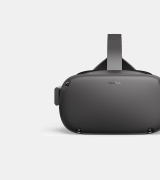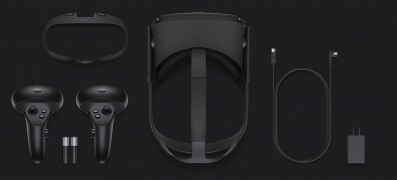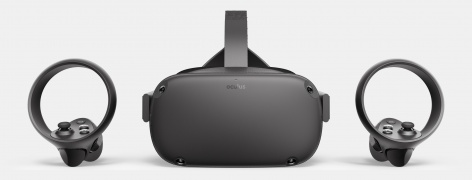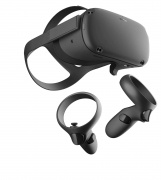Oculus Quest
| Oculus Quest | |
|---|---|
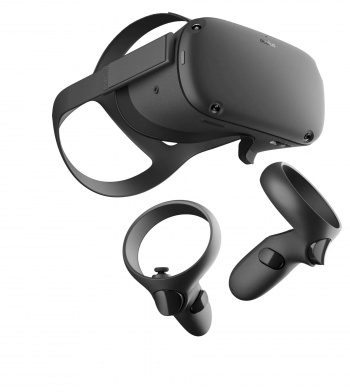
| |
| Basic Info | |
| VR/AR | Virtual Reality |
| Type | Head-mounted display |
| Subtype | Integrated HMD |
| Platform | Oculus Quest Platform |
| Developer | Oculus VR |
| Release Date | May 21, 2019 |
| Price | $399 (64GB), $499 (128GB) |
| Website | https://www.oculus.com/quest/ |
| Predecessor | Oculus Go |
| Successor | Meta Quest 2 |
| System | |
| Operating System | Android-based OS |
| CPU | Qualcomm Snapdragon 835 |
| GPU | Qualcomm® Adreno™ 540 |
| Storage | |
| Storage | 6GB, 128GB |
| Memory | 4GB |
| Display | |
| Display | OLED |
| Resolution | 1440×1600 per eye |
| Refresh Rate | 72Hz |
| Image | |
| Field of View | 96°×94° (estimated)(ref 5) |
| Optics | |
| Tracking | |
| Tracking | 6DOF |
| Rotational Tracking | Gyroscope, Accelerometer |
| Positional Tracking | Oculus Insight |
| Audio | |
| Camera | 4 |
| Connectivity | |
| Connectivity | Oculus Link, USB-C |
| Power | rechargeable headset, battery-operated controllers |
| Battery Life | 2 to 3 hours |
| Device | |
| Weight | 571grams |
| Input | Oculus Touch Controllers, Controller-free Hand Tracking |
| Size | 6.3 x 8.27 x 3.46 inches |
Contents
Introduction
The Quest was Oculus VR's first hybrid headset that was fully standalone and enabled a connection to PC for an expanded library of games. The Oculus Quest and Rift S were launched in the same year, but offered distinctly different playing experiences. The Quest is a fully integrated HMD, requiring no connection to a PC whereas the Rift S requires a PC for processing and play.[1]
You can purchase a refurbished Oculus Quest from Facebook for $199; the product has been discontinued, though, in favor of the Meta Quest 2.[2]
Release and Pricing
The Oculus Quest was first released on May 21, 2019 as a standalone headset.
On November 18, 2019, Oculus rolled out the ability to connect the Quest to a PC through the beta version of Oculus Link.[3]
In 2021, the Oculus Quest was discontinued.
Hardware
The Quest comes with strap audio - speakers built into the headset - but you can also connect your headphones through a stereo audio jack.
The CPU is a Qualcomm Snapdragon 835 that comes with 8 cores. Three of the faster “gold” cores are dedicated to game play, and the rest are dedicated to system services like TimeWarp and tracking.[4]
The GPU is a Qualcomm Adreno 540 which “cuts the scene up into a grid of tiles and renders each in sequence.”[4]
The Touch Controllers expand upon the design of Rift’s controllers. They have the same button layout, but the rings are placed differently to improve controller registration by the HMD.[4]
View the info box for an estimated field of view.[5]
System Requirements
This is the first Oculus product to allow for both integrated and discrete HMD play. You can play VR games from your desktop or laptop via Oculus Link or similar cables.
PC Requirements for Oculus Link
Processor: Intel i5-4590 / AMD Ryzen 5 1500X or greater
Memory: 8 GB+ RAM
Operating System: Windows 10
USB Ports: 1x USB port
Graphics:
- NVIDIA Titan X
- NVIDIA GeForce GTX 970
- NVIDIA GeForce GTX 1060 Desktop, 6 GB
- NVIDIA GeForce GTX 1070 (all)
- NVIDIA GeForce GTX 1080 (all)
- NVIDIA GeForce GTX 1650 Super
- NVIDIA GeForce GTX 1660
- NVIDIA GeForce GTX 1660 TI
- NVIDIA GeForce RTX 20 Series (all)
- NVIDIA GeForce RTX 30-series (all)
- AMD 400 Series
- AMD 500 Series
- AMD 5000 Series
- AMD 6000 Series
- AMD Vega Series
Setup Tutorial
Like the Quest 2, download the Oculus mobile app to configure your device. Purchase and download games through the app or while wearing your headset.
Input Devices
The Quest comes with two Touch Controllers as well as the ability to use your hands for controller-free hand tracking.
Accessories
Oculus Link
See Oculus Link. The Quest 2 is also compatible with this device.[2]
Oculus Quest in-ear Headphones
If you prefer headphones instead of the Quest’s built-in speakers, you can purchase Oculus’ in-ear headphones.[2]
Prescription Lenses
You can purchase prescription-strength VirtuClear® Lens Inserts for your Oculus Quest. They are 1.60 Hi Index Essilor lenses with anti-reflective coating meant to make your VR experience clearer. You can purchase through Frames Direct and will be asked for a valid prescription. The prescription range is SPH: 0 to -8.0 | CYL: 0 to -2.0.[7]
Apps
Oculus Quest Store
You can purchase games from the Oculus Quest Store on PC, mobile app, or from within the Store while wearing your headset.
Developer
The Oculus Quest has full support for Unity and Unreal engines as well as the Oculus SDK for games made outside of these engines.
Images
History
See Release and Pricing
References
- ↑ https://uploadvr.com/oculus-quest-2-specs/
- ↑ 2.0 2.1 2.2 https://www.oculus.com/quest/
- ↑ https://www.oculus.com/blog/play-rift-content-on-quest-with-oculus-link-available-now-in-beta/?locale=fr_FR
- ↑ 4.0 4.1 4.2 https://developer.oculus.com/blog/down-the-rabbit-hole-w-oculus-quest-the-hardware-software/
- ↑ https://uploadvr.com/field-of-view-tool-database/
- ↑ https://support.oculus.com/444256562873335/
- ↑ https://www.framesdirect.com/virtuclear-lens-inserts-for-oculus-quest.html
